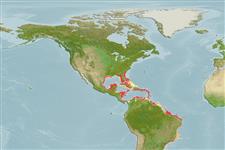Environment: milieu / climate zone / depth range / distribution range
Ecologie
marien rifbewoner; diepte 3 - 70 m (Ref. 9710). Subtropical; 33°N - 27°S, 98°W - 28°W (Ref. 5222)
Western Atlantic: Bermuda and northwestern Gulf of Mexico to Brazil. Report of this species (as Serranus acutirostris) from the Canary Islands is probably a misidentification of Mycteroperca fusca.
Grootte / Gewicht / Leeftijd
Maturity: Lm ? range ? - ? cm
Max length : 80.0 cm TL mannelijk / geslacht onbekend; (Ref. 5222); max. gepubliceerd gewicht: 10.0 kg (Ref. )
Dorsale stekels (totaal): 11; Dorsale zachte stralen (totaal): 15-17; Anale stekels 3; Anale zachte stralen: 10 - 12. Distinguished by the following characteristics: greyish brown color of head and body with irregular white spots and blotches; 3-4 dark brown stripes radiating posteriorly from the eye and continuing along the ventral half of the body as wavy dark stripes; dark brown stripe from maxillary streak to edge of preopercle; darker median fins with white spots and streaks; oblong and compressed body, depth of body 2.7-3.2 times in SL; head length 2.5-2.7 times in SL; width of maxilla 4.4-5.8% of SL; convex interorbital area; angular preopercle, enlarged serrae at the angle, forming a weak lobe; subequal sizes of anterior and posterior nostrils (Ref. 89707).
Maximum depth from Ref. 126840. Juveniles inhabit turtle grass beds, mangrove areas, and shallow waters among soft corals and coral reefs. Adults are found on rocky bottoms with high relief. Probably feeds on plankton (no information is available on the food of this species). The max weight of 4 kg given in Ref. 5222 appears too low. The species is a popular game fish in southern Brazil for both spear fishermen and rod-and-reel anglers. Fish of 4-7 kg are common, with the spear fishing record at 10.1 kg (Capt. Eduardo Baumeier, pers. comm., 2001).
Levenscyclus en paargedrag
Maturiteit | Voortplanting | Paaien | Eieren | Fecunditeit | Larven
Heemstra, P.C. and J.E. Randall, 1993. FAO Species Catalogue. Vol. 16. Groupers of the world (family Serranidae, subfamily Epinephelinae). An annotated and illustrated catalogue of the grouper, rockcod, hind, coral grouper and lyretail species known to date. Rome: FAO. FAO Fish. Synop. 125(16):382 p. (Ref. 5222)
Status op de Rode Lijst van het IUCN (Ref. 130435)
Gevaar voor de mens
Harmless
Gebruik door de mens
Visserij: van minder commercieel belang; sportvis: ja
Meer informatie
Lokale namenSynoniemenMetabolismePredatorenEcotoxicologieVoortplantingMaturiteitPaaienPaaiaggregatiesFecunditeitEierenOntwikkeling van de eieren
ReferentiesAquacultuurAquacultuurprofielKweeklijnenGeneticaElectrophoresesErfelijkheidZiektesVerwerkingNutrientsMassaconversie
Tools
Speciale rapporten
Download XML
Internetbronnen
Estimates based on models
Preferred temperature (Ref.
123201): 23.7 - 28, mean 26.8 °C (based on 224 cells).
Fylogenetische diversiteitsindex (Ref.
82804): PD
50 = 0.5000 [Uniqueness, from 0.5 = low to 2.0 = high].
Bayesian length-weight: a=0.01047 (0.00604 - 0.01816), b=3.03 (2.89 - 3.17), in cm total length, based on LWR estimates for this species & Genus-body shape (Ref.
93245).
Trofisch niveau (Ref.
69278): 3.4 ±0.45 se; based on food items.
Weerstandsvermogen (Ref.
120179): laag, minimale populatieverdubbelingstijd 4,5-14 jaar (Preliminary K or Fecundity.).
Fishing Vulnerability (Ref.
59153): Moderate to high vulnerability (52 of 100).
Nutrients (Ref.
124155): Calcium = 17.2 [9.2, 35.0] mg/100g; Iron = 0.522 [0.268, 0.914] mg/100g; Protein = 19 [17, 21] %; Omega3 = 0.178 [0.103, 0.312] g/100g; Selenium = 16.9 [7.9, 36.4] μg/100g; VitaminA = 64.4 [20.6, 226.8] μg/100g; Zinc = 0.668 [0.440, 1.027] mg/100g (wet weight);
